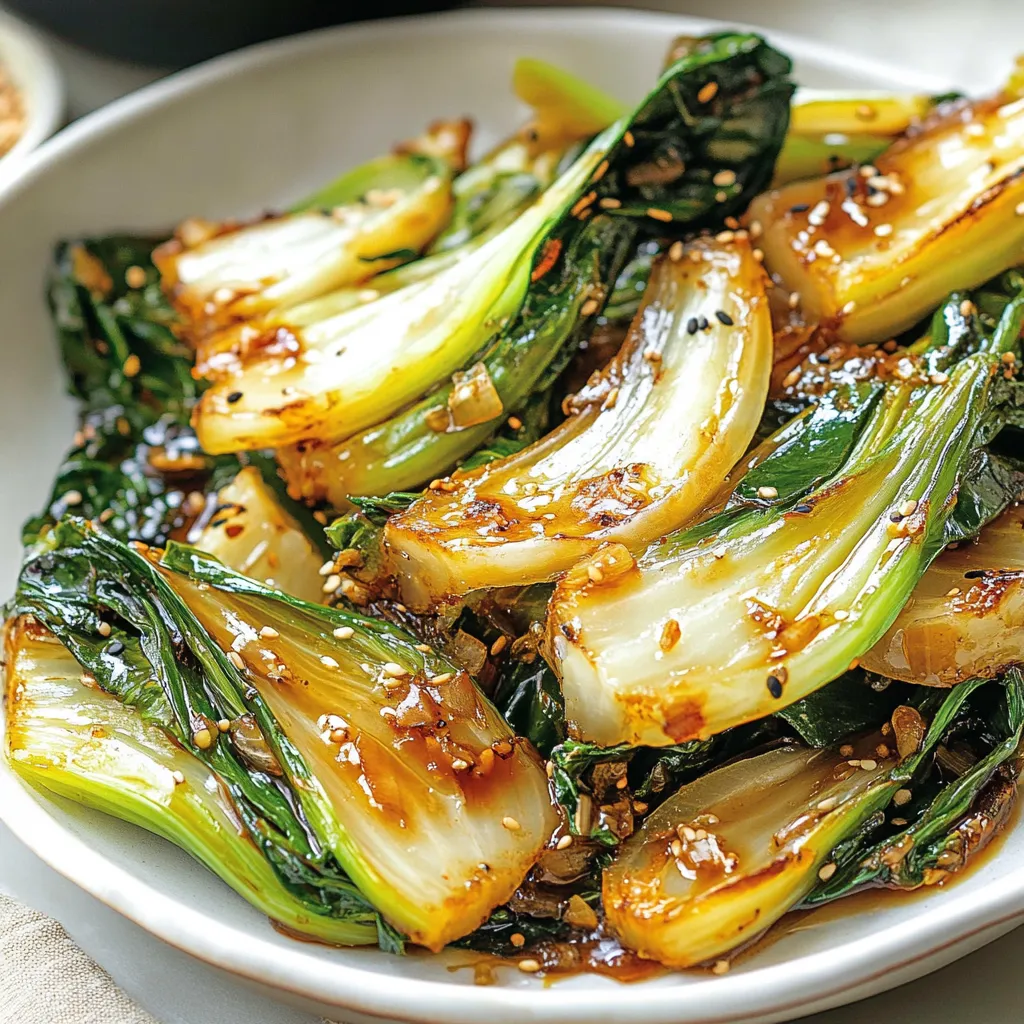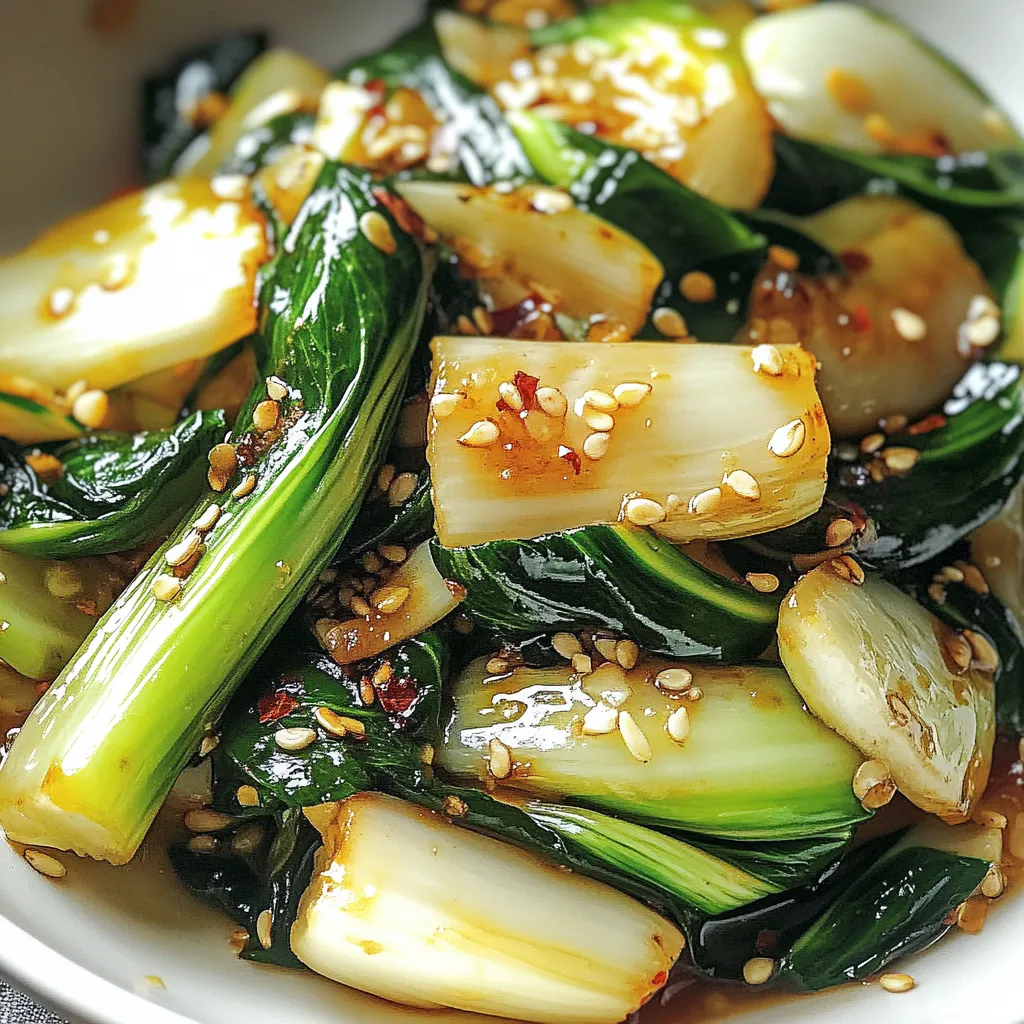 Pin it
Pin it
This sautéed bok choy recipe transforms a simple vegetable into a delicious side dish in just five minutes. The combination of garlic, soy sauce, and sesame oil creates a perfect balance of Asian-inspired flavors that complement the crisp stems and tender leaves of the bok choy.
I first made this recipe when I needed a last-minute vegetable side dish for an impromptu dinner party. The simplicity and flavor impressed my guests so much that it's now my go-to recipe whenever I spot fresh bok choy at the market.
Ingredients
- Olive oil: Provides the base for sautéing without overwhelming the delicate bok choy flavor
- Sesame oil: Adds that distinctive nutty flavor that elevates the dish to restaurant quality
- Fresh garlic: Adds aromatic depth look for firm cloves without any green sprouts
- Bok choy: Choose bunches with crisp white stems and vibrant green leaves
- Soy sauce: Brings the perfect savory umami element choose low sodium if watching salt intake
- Water: Helps create steam to perfectly tenderize the bok choy without overcooking
Step-by-Step Instructions
- Heat the Oils:
- Add both the olive oil and sesame oil to a non-stick skillet over medium heat. Wait until the oil begins to shimmer slightly which indicates it's properly heated. This combination creates the perfect flavor base while preventing the delicate sesame oil from burning.
- Add Garlic:
- Add minced garlic to the heated oil and cook for exactly one minute, stirring constantly to prevent burning. The garlic should become fragrant but not brown, as this would create bitterness in the final dish.
- Cook Bok Choy:
- Add the quartered bok choy to the pan with the fragrant garlic and cook for one minute, allowing the bok choy to begin wilting slightly. Then add the soy sauce and a few tablespoons of water to create steam that will help cook the thicker stems.
- Steam to Perfection:
- Cover the pan immediately after adding the liquid and allow the bok choy to steam for precisely 3 minutes. This creates the perfect texture where the stems remain slightly crisp while the leaves become tender.
- Serve Immediately:
- Remove the pan from heat and transfer the bok choy to a serving dish right away. The residual heat will continue cooking the vegetables, so prompt serving ensures the perfect texture.
 Pin it
Pin it
The sesame oil is truly the secret ingredient in this recipe. I once tried making it without when I ran out and while still good, it lacked that distinctive Asian restaurant quality that makes this dish special. My family immediately noticed the difference and requested I never skip it again.
Perfect Pairings
This sautéed bok choy makes an excellent side dish alongside Asian-inspired main courses. Try serving it with teriyaki salmon, beef and broccoli, or even a simple bowl of steamed rice topped with a fried egg. The clean, slightly bitter notes of the bok choy balance rich, savory dishes beautifully.
Selecting the Best Bok Choy
When shopping for bok choy, look for bunches with firm, white stems that transition to crisp, vibrant green leaves. Avoid any with wilting, yellowing leaves or slimy spots. Baby bok choy works wonderfully in this recipe too and requires even less cooking time. For the freshest flavor, try finding bok choy at Asian markets or farmers markets where turnover is higher.
Flavorful Variations
While this recipe is perfect in its simplicity, you can customize it to your taste preferences. Add red pepper flakes or a drizzle of chili oil for heat, substitute coconut aminos for soy sauce to make it gluten free, or sprinkle with toasted sesame seeds for added texture. For a heartier version, add sliced mushrooms or thinly sliced carrots at the same time as the garlic.
 Pin it
Pin it
Serve this simple, vibrant dish to elevate your meals with minimal effort. It’s sure to become a household favorite!
Frequently Asked Questions
- → How do I prepare bok choy before cooking?
To prepare bok choy, first trim off the bottom inch of the stem end. Separate the leaves and rinse thoroughly under cold water to remove any dirt or sand trapped between the layers. Pat dry with paper towels before quartering lengthwise for even cooking.
- → Can I substitute baby bok choy in this dish?
Yes, baby bok choy works wonderfully as a substitute. Since it's smaller and more tender, you may want to halve rather than quarter it, and reduce the cooking time by about a minute to prevent overcooking.
- → What protein pairs well with sautéed bok choy?
Sautéed bok choy pairs excellently with grilled or roasted chicken, salmon, shrimp, tofu, or beef. The soy-garlic flavors complement most Asian-inspired mains, making it versatile for various meal combinations.
- → Can I make this dish spicy?
Absolutely! Add red pepper flakes or a drizzle of chili oil to introduce heat. For more complex spice, consider adding a teaspoon of gochujang (Korean chili paste) or sriracha to the soy sauce mixture.
- → Is there a low-sodium alternative to soy sauce for this dish?
Yes, you can use low-sodium soy sauce, tamari, or coconut aminos as alternatives. Coconut aminos provide a slightly sweeter profile but work well with the other flavors in the dish while significantly reducing sodium content.
- → How can I tell when bok choy is perfectly cooked?
Perfectly cooked bok choy should have bright green leaves that are wilted but not mushy, while the white stalks should be tender-crisp with some resistance when pierced with a fork. The bok choy should maintain its structure but be easily cut with a fork.
